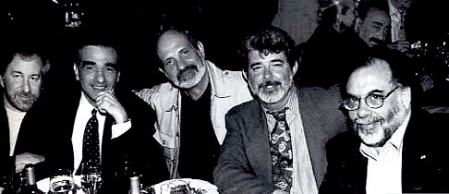The New Hollywood and Independent Film Making
 |
| photo from: http://www.unitedliberty.org/articles/14185-hollywood-full-time-employees-physicians-brace-for-obamacare |
I. The New Hollywood and Independent Film Making
A. Hollywood started to decline in 1960's because of falling to attract the american audience.
* Remember this post The Hollywood Style this is the before the decline.
B. They go to independent film directors called the movie brats who created films for the young generation.
* More on this from my post The Film School Generation
 |
| Film Brats photo from: http://www.angelfire.com/de/palma/blog/index.blog?topic_id=1058991 |
C. The directors who have gone to film school's have highly respect for the older directors by being verbal in telling their admiration and making films inspired by the works of the former holly wood film makers.
1. Steven Spielberg - "l love the idea of not being an independent filmmaker. I've liked working within the system. And l've admired a lot of the older directors who were sort of 'directors for hire.' Like Victor Fleming was in a contract all those years to Metro and Selznick and Mayer . . . he made Captains Courageous. And you know, his most famous films: Wizard of Oz and Gone with the Wind."
2. ex.Brian de Palma's 1980 film (Dress to Kill) were influence by Hitchcock's Psycho as said in the book.
D. "The movie brats worked in traditional genres, but they also tried to give them an autobiographical coloring." Quoted in the book, as to my understanding they applied what they learned in film school and but personal factors ad up to the mix in their movies influence (I use this word because the book use the words film buff directors) by the french new wave.
ex. (given in the book)
1. American Graffiti by George Lucas - I learn that it is not only a teenage musical but also the director's way of showing how he perceive about living in California.
American Graffiti trailer
2. Mean Streets by Martin Scorsese - of him living in New York
Mean Streets theatrical trailer
3. Godfather by Francis Coppola - about Italian American Family
Godfather trailer
E. High respect for European film tradition.
1. Directors like:
a. Martin Scorsese - who are said to be influence by Luchino Visconti and British director Michael Powell on the visual aspect.
b. Francis Coppola's 1974 film The Conversation influence by Antonioni's BIow-Up (1966)
F. There are directors from abroad like the examples given in the book in britai
Britain (Tony and Ridley Scott)
Australia (Peter Weir, Fred Schepisi)
Germany (Wolfgang Peterson)the Netherlands (Paul Verhoeven), and Finland (Rennie Harlin). came to Hollywood
G. There are women directors who arise during this era.
examples in the book although I may not know them are:
1. Amy Heckerling (Fost Times at Riclgemont High, 1982)
2. Martha Coolidge (Valley Girl, 1983)
3. Penelope Spheeris (Wavne's Worlcl, 1992).
H. Familiar directors of today arise during 1980's who are describe as the a part of the new new Hollywood like:
1. James Cameron (Titanic)
2. Tim Burton (I thing he is the director often collaborating with Johnny Deep's films like 1990's Edward Scissorhands)
3. Robert Zemeckis (Back to the Future) - one of my most favorite movies of all time. :D
I. Style: Continuity Editing still continues but the directors played up and introduced different techniques in shooting and editing. I learn that most of them played up with the visual techniques and challenging the narrative to have a parallelism of themes like drama and psychological aspects in one film.
J. Studios are starting to buy independent films to be remake as mainstream. One good example if you are familiar, I learned in the book that Sundance Film Festival somehow became a place where mainstream producers choose independent films or even actors for the mainstream movies.
Summarize: All in all there are three main points that I understood in the text.
1. There is no comparison or even a contest to which is better the classical or the film brats, the Americans or the one's in abroad; male or female directors. They all get inspiration from each other and it produces great films that we are now able to watch.
2. The Independent and New Hollywood directors have somehow personalize their works by creating movies in connection to their experiences and to what their target audience are experiencing at the present.
3. In their filming and editing style two things: narrative and continuity editing will always be present. Although as time past the directors played up in their techniques to continue what the I first learn the Hollywood aims which is to make the audience believe they are involve in the and present in the film.
No comments:
Post a Comment